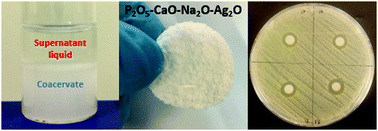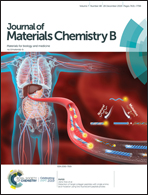Antibacterial silver-doped phosphate-based glasses prepared by coacervation†
Abstract
Phosphate-based glasses are materials of great interest for the regeneration and repair of damaged hard or soft tissues. They have the desirable property of slowly dissolving in the physiological environment, eventually being totally replaced by regenerated tissue. Being bioresorbable, they can simultaneously induce tissue regeneration and deliver therapeutic agents (e.g. antibacterial ions) in a controlled way. In this work, we have synthesised a series of glasses in the P2O5–CaO–Na2O system doped with Ag2O using the coacervation method. The addition of silver is known to provide the glass with antibacterial properties due to the release of Ag+ ions into the body fluid. The coacervation method is a facile, water-based technique which offers significant advantages over the conventional melt-quench route for preparing phosphate-based glasses which requires melting of metal oxide powders at high temperatures (1000–1200 °C). The properties of the initial colloidal polyphosphate systems (coacervates) as a function of the Ag2O content were characterised using rheology and liquid state 31P NMR. The effect of Ag+ addition on the final dried glasses was investigated using thermal analysis, Raman spectroscopy and X-ray diffraction. The antibacterial activity was assessed against Staphylococcus aureus (S. aureus), a bacterial strain commonly found in post-surgery infections. A dose-dependent antimicrobial effect was seen with an increasing silver content.



 Please wait while we load your content...
Please wait while we load your content...